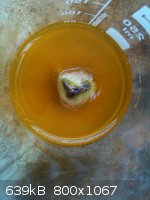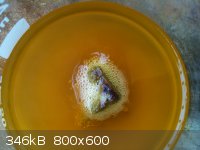Megamarko94
Hazard to Self
 
Posts: 68
Registered: 31-12-2010
Member Is Offline
Mood: No Mood
|
|
determining type of ore
i have trouble determining what element ore is this.
i did few tests and my results are next:
Color of ore red brown
i disolved some of it in HCl and i got yellow orange solution and looks like FeCl3 and i tought it is iron, than i added NaOH in a test tube and no
reaction observed.
Flame test of the solution was giving blue green flame.
With HNO3 no precipitate but solution darken a little bit.
With dilute H2SO4 i got light yellow precipitate looks like hydrate form.
If anyone knows what cation is this or any other tests i can do plz tell me.
|
|
|
Boffis
International Hazard
    
Posts: 1836
Registered: 1-5-2011
Member Is Offline
Mood: No Mood
|
|
Hi Megamarko94
I could be uranium, ores of this metal can be almost any colour from black to bright yellow and shades of orange and brown are common in partly
oxidized pitchblende known as "gummite". The latter are waxy or resinous heavy amorphous material and are difficult to characterise. They dissolve
easily in dilute acid and can contain many other elements in small amounts, particularly lead. When high in uranium and low in other metals the
solution is usually vivid yellow with a slight green fluorescence but impurities quickly mask this affect.
If an excess of NaOH is added so called sodium uranate is precipitated but if the solution of sodium hydroxide is old and has absorbed carbon dioxide
no precipitate will form because uranium forms a soluble carboxyuranate ion with excess carbonate.
The reaction with sulphuric acid is complicated by the presence of other metals unless there is a large excess of acid when only the lead barium and
calcium type metals precipitate.
A simple and fairly conclusive test ias follows ; dissolve a little of the ore in dilute nitric or hydrochloric acid (not sulphuric acid) avoiding a
large excess. Add hydrogen peroxide and a pale yellow precipitate of uranyl peroxide will form if uranium is present. Several other metals produce
precipitates or colour with this reagent but if you then add an excess of sodium carbonate the uranium precipitate will dissolve again giving a deep
yellow orange solution.
The only alternative I can think of is chromate but natural chromates are very rare and the ones from europe and north america are mostly lead
chromates and are not decomposed by dilute acids.
Do you know where the material came from as this would be a good guide?
|
|
|
Megamarko94
Hazard to Self
 
Posts: 68
Registered: 31-12-2010
Member Is Offline
Mood: No Mood
|
|
Material is from southeastern europe, i found it in my village it was standing out from the rest of the rock so i tought why not take a sample and see
what it is.
Here are couple of pics disolving, solution goes more orange after some time.
 
[Edited on 12-7-2011 by Megamarko94]
|
|
|
blogfast25
International Hazard
    
Posts: 10562
Registered: 3-2-2008
Location: Neverland
Member Is Offline
Mood: No Mood
|
|
Before you've at least half digested it, the ore's composition will not reveal itself. So you'll need to grind some of it extremely finely and subject
it to various extreme conditions like conc. H2SO4, fusion with bisulphate, conc. HCl, fusion with alkali or boiling with 50 % KOH. Then some chemical
tests may reveal something about its chemistry. To be honesr, its no mean task for anyone: ore analysis....
The fizzing clearly points to a carbonate matrix (CO2 being released by acid action: the red may be iron oxide - suspended in it and which will NOT
necessarily dissolve in your conditions). Try filtering to clear and evaporating the filtrate: what do you get?
[Edited on 12-7-2011 by blogfast25]
|
|
|
Neil
National Hazard
   
Posts: 556
Registered: 19-3-2008
Member Is Offline
Mood: No Mood
|
|
Can you take a picture of it in its host rock?
If it is fizzing in HCl, burning blue/green and making reddish/yellow solutions it may be a mixture of iron/copper carbonates which means -
Before you start boiling things you may want to look for signs of Arsenic.
|
|
|
kryss
Hazard to Self
 
Posts: 77
Registered: 11-7-2003
Location: N Ireland
Member Is Offline
Mood: No Mood
|
|
Have a look at some mineralogy website that will probably help, things like hardness are relatively easy to do, they also do a thing called a streak
test which helps
|
|
|
Boffis
International Hazard
    
Posts: 1836
Registered: 1-5-2011
Member Is Offline
Mood: No Mood
|
|
Yes this looks like a carbonate and the colour is definitely due to a dispersion of fine iron oxide material; you didn't mention the effervescenes
before. As a carbonate that dissolve easily it is likely to cantain calcium hence the precipitate of gypsum when you add sulphuric acid.
What make you interested in this material and why do you think it is an "ore". This would imply that it contains a metal /element of value. Knowing
what metal might be present gives us some idea of of what else might be associated.
|
|
|
blogfast25
International Hazard
    
Posts: 10562
Registered: 3-2-2008
Location: Neverland
Member Is Offline
Mood: No Mood
|
|
Quote: Originally posted by Boffis  | | Yes this looks like a carbonate and the colour is definitely due to a dispersion of fine iron oxide material; [...] |
I'd say, 'definitely maybe', rather than 'definitely'. Gather some of the red material on a filter, scrape it off and subject it to hot conc. H2SO4 or
prolonged refluxing with conc. HCl: if iron is present some (or all) will go into solution. Test with KSCN for red colour due to FeSCN(2+). Use blanks
to exclude any iron coming from H2SO4 or HCl...
[Edited on 13-7-2011 by blogfast25]
|
|
|
Megamarko94
Hazard to Self
 
Posts: 68
Registered: 31-12-2010
Member Is Offline
Mood: No Mood
|
|
Quote: Originally posted by Boffis  |
What make you interested in this material and why do you think it is an "ore". This would imply that it contains a metal /element of value. Knowing
what metal might be present gives us some idea of of what else might be associated. |
I am not sure if it is an ore, i was intersted to find out composition of it cause there is a lot of difrent types of rock and ores, also i saw some
greenish blue colored material if you know what could that be ,i'll take sample of it next time.
if it was iron oxide and i disolved it in HCl which probably gave FeCl3 why doesnt react with NaOH to give red color of Fe(OH)3.
[Edited on 13-7-2011 by Megamarko94]
|
|
|
Megamarko94
Hazard to Self
 
Posts: 68
Registered: 31-12-2010
Member Is Offline
Mood: No Mood
|
|
I will try that soon as i get KSCN...
|
|
|
blogfast25
International Hazard
    
Posts: 10562
Registered: 3-2-2008
Location: Neverland
Member Is Offline
Mood: No Mood
|
|
Another easy test relies on the fact that Fe<sup>3+</sup> solutions are somewhat thermochromic: when heated they visibly darken (due to
hydrolysis of the [Fe(H<sub>2</sub>O)<sub>n</sub>]<sup>3+</sup> ion) and return to their initial colour when
cooled again.
|
|
|
Megamarko94
Hazard to Self
 
Posts: 68
Registered: 31-12-2010
Member Is Offline
Mood: No Mood
|
|
ok so i heated the solution and it doesnt darken at all so its not thermochromic....
|
|
|
blogfast25
International Hazard
    
Posts: 10562
Registered: 3-2-2008
Location: Neverland
Member Is Offline
Mood: No Mood
|
|
How did you obtain the solution? You see, mineral Fe2O3 is unlikely to be very soluble because of its structure. You really need to treat some of the
red stuff with hard hot, conc. H2SO4 or hot, conc. HCl.
|
|
|
Megamarko94
Hazard to Self
 
Posts: 68
Registered: 31-12-2010
Member Is Offline
Mood: No Mood
|
|
i disolved it in conc. HCl and outside was about 40c* it disolved pretty easy but small amount of green precipitate was left in beaker...
|
|
|
Boffis
International Hazard
    
Posts: 1836
Registered: 1-5-2011
Member Is Offline
Mood: No Mood
|
|
I think whats needed here is to take a few steps back and consider the geology of the source of the material.
Is it from an old mining area? If yes what did they mine?
Are you sure the material is natural ie not a slag?
Forget the strong acids for a while and try dilute acids (7-10% usually depending on the acid) is adiquate.
If it effervesces with 10% nitric acid its a carbonate. Don't heat it yet. Filter off the red material and divide the clear filtrate. What colour is
it? (nitric acid only dissolves natural occurring Ca, Sr, Ba, Pb and Na carbonates in the cold. The common Mg, Zn, Mn and Fe bearing carbonates
dissolve only on heating. Mn cabonates rapidly turn black on exposure to the weather)
To one portion add dilute sulphuric, an immediate very fine precipitate most like indicates Pb, Ba or Sr . Calcium precipitates more slowly as
crystals, if the solution is dilute these may take minute to appear as delicate blades (microscope).
To another portion add HCl, a white precipitates indiates Hg+, lead or silver but the first and last of these are unlikely to have dissolved in the
first place. To confirm lead add a very little potassium iodide, if the precipitate turns yellow it probably lead, try boiling the suspension for a
moment and cooling the lead iodide should partly dissolve and the recrystallize on cooling as beautiful yellow glistening scales. (Note too much KI
will caus ethe ppt to dissolve completely)
To another portion add ammonia solution drop by drop and observe what happens. Once the excess acid has been neutralized a precipitate should form,
remember that ammonia often contains carbonate ions so a white precipitate could form since an alkaline earth metal is probably present. If a brown or
greenish grey but quickly turning brown =iron, copper gives a pale blue precipitate but it is easily masked by a little iron. However, if you keep
adding ammonia until the liquid smell strongly and let the precipitate settle copper nickel and cobalt will go back into solution to give blue ammino
complexes. They differ slightly in colour and the cobalt one rapidly turns orange.
For the original insoluble brown material warm with dilute HCl an treat as suggested by Blogfast. You don' need conc acids, natural hydrated iron
oxides are fairly soluble in warm dilute acid. On the slight chance no iron is present we will have to consider other option
|
|
|
Megamarko94
Hazard to Self
 
Posts: 68
Registered: 31-12-2010
Member Is Offline
Mood: No Mood
|
|
ok after some time i decided to do the tests you suggested.
results:
substance is putted in 10% nitric acid, gas is released, probably (CO2)
after removing filtrate from solid, clear solution is obtained.
with dilute H2SO4 (40-50%) white crystals start to appear after few seconds.
with HCl solution goes clear yellow.
with NH4OH very light blue color shows with small amount of precipitate.
quick question : how do you upload a picture without having to change the size of it?
[Edited on 11-9-2011 by Megamarko94]
|
|
|
Endimion17
International Hazard
    
Posts: 1468
Registered: 17-7-2011
Location: shores of a solar sea
Member Is Offline
Mood: speeding through time at the rate of 1 second per second
|
|
Bang, right in the spot. Uranium, right. Cause its ores just lay around, everywhere.
|
|
|